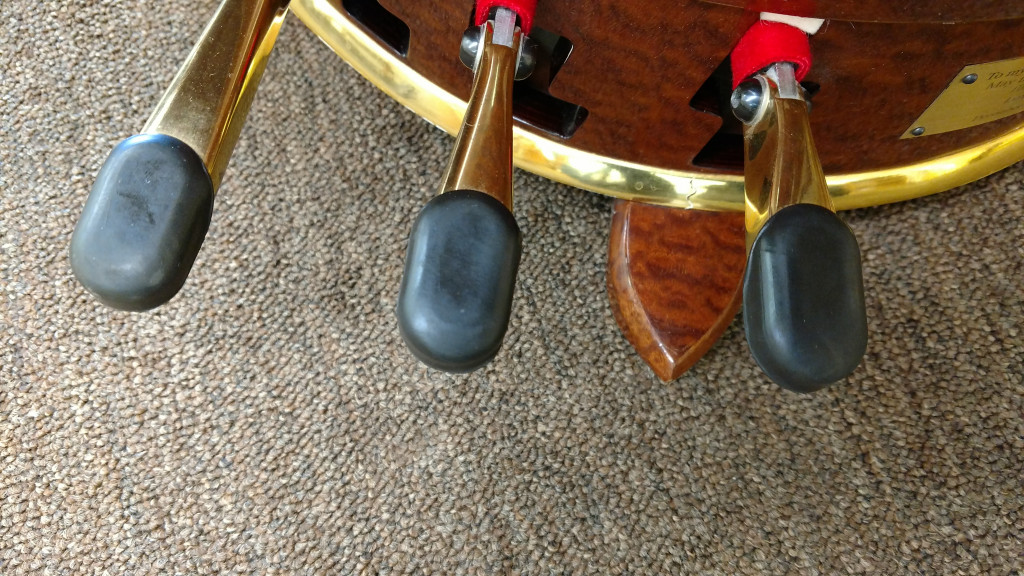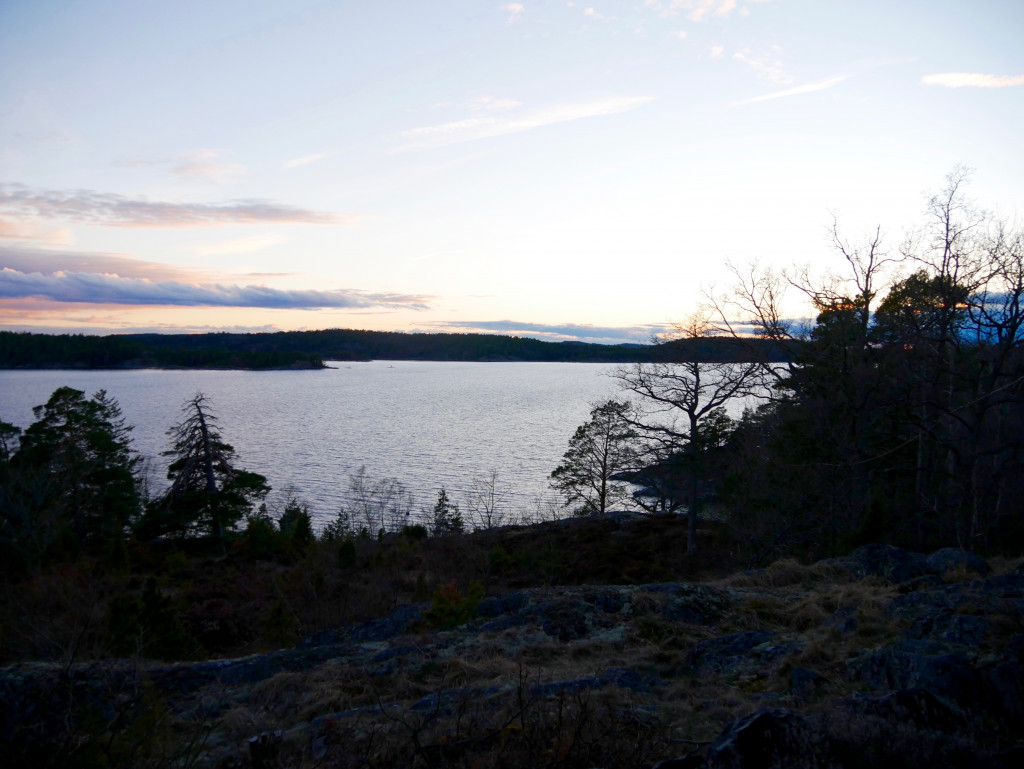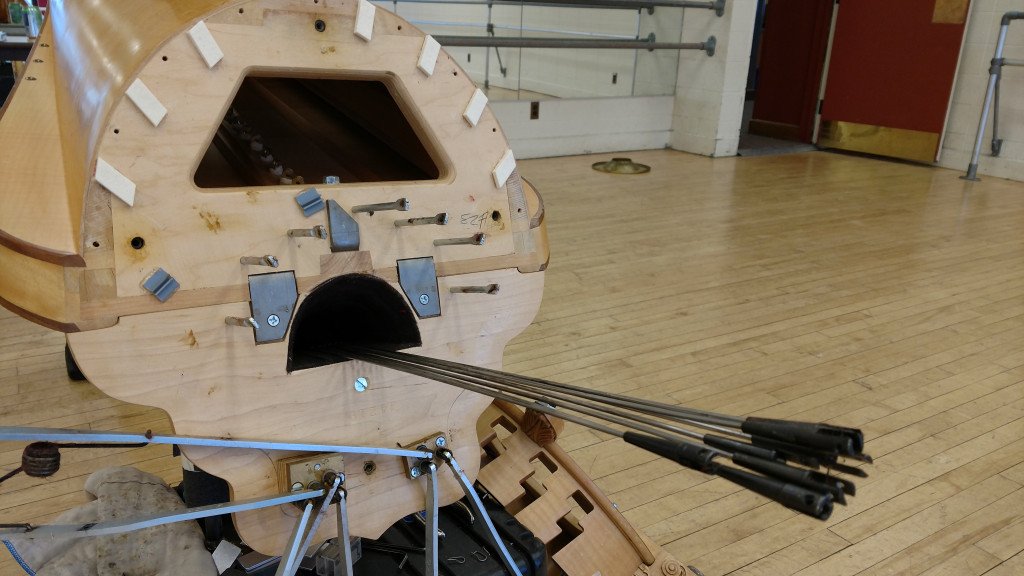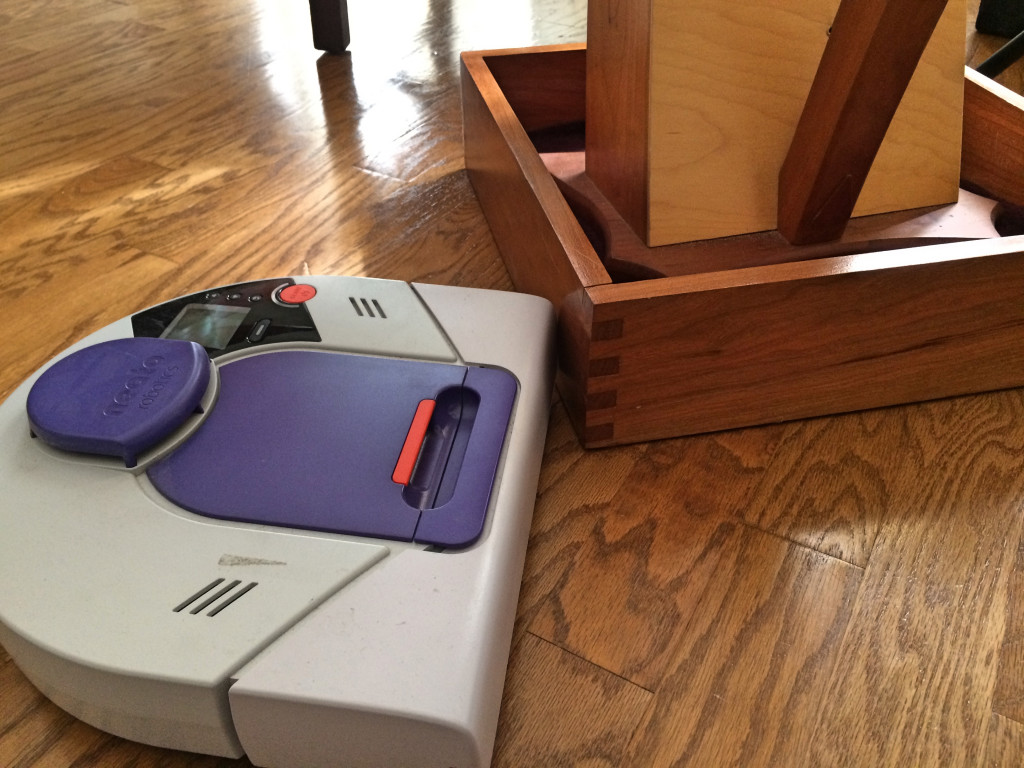Between day jobs, freelance gigs, teaching, babies and Chicago rush hour traffic, finding the time for all 4 members of the Chicago Harp Quartet is difficult to say the least. But, we were able to find 7 hours this past week for a marathon CHQ rehearsal and dinner meeting before the Memorial Day weekend.
The majority of our rehearsal was spent working on a very exciting new commission by Nick Davies. Each movement in this work, Five Portraits, is based on a different influential artist: Igor Stravinsky, Salvador Dali, Martha Graham, e.e. cummings, and John Steinbeck. We’ve each spent weeks working on our own and with Nick on our individual parts trying to make things work and honor his intentions. Besides a very exhausted slap happy sight reading session back in March while we were on tour in Philadelphia, this rehearsal was the first time we’ve sat down together to conquer this piece as a quartet. (There are several slaps, scrapes, and string bending parts that made us all very giggly when we were sleep deprived and exhausted from hours of school presentations, rehearsals and moving 4 harps in a new city.) This work, I am confident, is going to be a #winner for the CHQ. The premiere will take place July 10th at the Lyon & Healy Summer Festival and Nick is flying in from Aspen to be there! We are also performing this piece for a week long collaboration – Y Portraits: Awakening. This groundbreaking project explores the awakening of identify with a living gallery featuring Generation Y painters, musicians, actors and video artists from all over the world the last week of July in Chicago with Mozawa and Ho Etsu Taiko.
Here is what Nick has to say about Five Portraits:
“When approached by Lynn Williams about the opportunity to write a piece for harp quartet, I was simultaneously thrilled to have the opportunity while also realizing the serious challenge of writing for, yes, four harps, a fact which I had to clarify for many a colleague of mine. But in fact, what resulted was a wonderful exercise in creating five distinct character pieces which, as per the stipulation of the commission, must reflect five different significant people from history. In addition, there was a desire to reflect or juxtapose my generation onto those of whom I picked. In response, I chose Igor Stravinsky, Salvador Dalí, Martha Graham, e.e.cummings and John Steinbeck, which in this order, reflect the dedications of each movement. The people not only reflect the generation of art representative from the 1920s through the 1940s, but more importantly serve as some of the inspirational figures in my artistic palette.
Part of the issue in writing pieces dedicated to specific people is twofold – one, audience members and musicians alike will already have their predisposed assumptions in their head about the person in mind and will have a certain expectation as to what the music should sound like. The music that I write must therefore be persuasive enough that there is no doubt that, say, the Dalí music really sounds like Dalí. Secondly, finding a musical model that would serve dual purpose of providing dramatic and musical structure to both the music and the respective personages proved difficult. What makes sense in the “language” or “story” of the music such that each person’s spirit is reflected not as an individual portrait but to indicate a continuous arch?
I found the solution in an arch form structure, linking the musical materials found in movements one and five, two and four, and then three stands on its own. Not only does this make musical sense, but it also reflects the meaning of the dedications and how these influential figures also influenced one another. In addition, the musical materials have been arranged such that, dramatically, I aim to navigate us from start to end with a highly directed focus, much like a symphony.
The first movement, titled Processional, is a slow but strident march, much influenced by seminal works by Stravinsky such as Symphony du Psalms and Symphony in Three Movements. The movement is mostly built on a small grace note motive heard at the beginning while the harmony is built on sets of rigid fifths, giving the movement an austere quality that propels itself into a lyrical middle section. This part of the movement still holds the austere, dead pan fifths while integrating a new melody in the “wrong” key, which resolves itself in a broad and elongated articulation of the augmented melody. Returning to the opening section, the movement ends with a huge glissando gesture in a new, enlivened and uplifting harmony.
The Dalí movement, I believe aptly titled Grotesque, is a scherzo inspired by another processional as depicted in Dalí’s Temptation of St. Anthony. Rather than delve into the religious overtones of the work, I have always been fascinated by the enormous spindly-legged elephants which form most of the subjects on the canvas. For me, this translates into a heavy handed and humorous dance, set to a mixed meter melody that never seems to arrive at a point where it is satisfied. Beneath all of this is an ostinato underpinning which never settles on a clear harmony, always shifting before we can mark it down. To contrast this, a stagnant, dream like trio is ushered in, undulating in a sort of hypnotic blur. The scherzo then returns in full force before evaporating as though it never had occurred.
The third movement, titled Pas de Quatre, is a dance cast by two characters, one angular and one lyrical. The movement takes its inspiration from works such as Appalachian Spring which combined the “traditionalist” music of Copland with the avant-garde of Graham. The result musically is a series of interactions between the two characters, some confrontational, some cooperative, and some ecstatically enthralled. Ultimately though, the two bow out with grace, somewhat saddened and melancholy at their departure.
The next movement, Stanzas, is a meditation on musical material derived from the harmonically stagnant trio of the Dalí movement. Dedicated to e.e. cummings, the piece is reminiscent of poems such as [in Just-], which are simple, fragmented and yet flow with an incredible poise. Here, the melody is fragmented too over a series of four episodes, most of which end in similar cadential sequences. Little pieces of the melody serve as accompaniment, like little refrains or commentary. In effect, the movement is a palate cleanser which ruminates upon itself before fading too.
The finale, titled Cannery Row, is a tour de force for the harps, and takes its title from a novel by John Steinbeck. The title however is somewhat misleading, because the movement also is influenced by other works such as Of Mice and Men and East of Eden, and was in fact originally and more generically titled “Rejouissance”. The movement, along with the novels, is about the freedom of the human spirit, to live and choose as it may. This is a general character of the work as a whole, but this movement in particular takes an opportunity to extrapolate and capitalize on this idea, as is clear by the jubilant character cast by the music. The movement takes the form of a loose rondo, iterating the main theme (again, using motivic figures found in the first movement) at the beginning, the middle and the very end. In-between these sections are variations and transformations of the main themes, the first quirky and flowing, the second transcendental, the third a strident reminiscence of the Processional, and the fourth a contrapuntal crescendo into the ecstatic finale. The music takes one last glance at the Processional again before climaxing in an energetic outburst.
The celebratory nature of the work is in part due to the characters that I depict, each being beloved figures in the world of the arts, but more broadly due to the freedom that it gives the rest of us to build upon as artists looking forward. It is intimidating and awe inspiring to read, watch, look, listen, or to play the works of these men and women, but that is what gives us reason to move forward and share what we as musicians are privy to day in and day out.”
We also rehearsed for our upcoming concert the end of this month at City Winery. The Chicago Philharmonic Chamber Places (cp2) Presents Series will feature dance music from Handel to Muse. It’s refreshing for all of us to bring back old repertoire we’ve put away for a while, Handel’s Hornpipe and MLW’s Musings.
We also read through some new pieces for next season: Bruce Broughton’s Dancing for Love, Dancing for the Gods (2015) commissioned and dedicated to Skaila Kanga and the Harp Department at the Royal Academy of Music, London (Thanks Skaila!) and Lynn’s new arrangement of the famous Anitra’s Dance from Peer Gynt Suite. (Now we are trying to talk her into arranging In the Hall of the Mountain King for us…)
Our dinner break replaced our weekly conference call and we were able to knock out a lot of To-Do’s in an hour. Kelsey even brought us cheese curds from Wisconsin and Lynn’s kitties visited with us until we started with the wire slaps… 🙂













